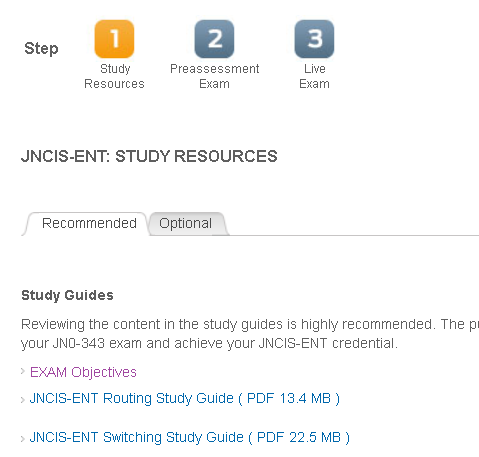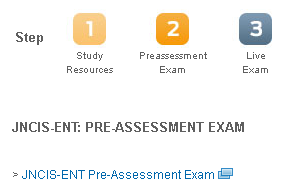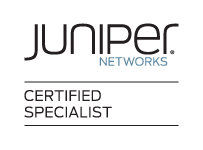Depois do Exame JNCIA-Junos e conforme já havia comentado aqui decidi seguir o track Enterprise. Assim sendo hoje realizei o JNCIS-ENT e posso que dizer provisoriamente que passei :)
Hoje realizei o exame JN0-343 da Juniper, este exame é também abrangido pelo “Fast track Program” e como tal 50% desconto se passar no assessment. Não faz sentido comparar a dificuldade deste exame com o JNCIA, mas o realizado hoje foi bastante interessante pois apesar ter pouca experiência com Juniper senti-me confortável apesar de ter que melhorar alguns dos tópicos como “High Availability”.
Pré-Requisitos
É necessário ter o JNCIA-Junos
Material de Estudo
Como material de estudo usei os documentos disponibilizados pela Juniper, para realizar o download será necessário realizar o registo no Learning Portal, este passo é importante pois o Pre-assessment que irá garantir o voucher será realizado apartir deste.
Para testar tecnologias como routing o Juniper Olive é perfeito, basicamente é um junOS virtualizado/emulado. As relacionadas com Switching/High Availability entre outras usei os Virtual Labs (acho que só os partners têm acesso), o único senão é que a release dos EX/MX é a 11.x e a recomendada para estudo é a 12.x. Devido a este facto não consegui testar por exemplo o Ethernet Ring Protection Switching e o Multitopology.
Em suma os passos foram:
Importante:É necessário estar autenticado no Learning Portal para aceder aos conteúdos
Após autenticar, abrir Fast Track Portal, são exibidas 2 colunas, abaixo encontra-se representada a coluna da direita. Escolher os recursos de estudo “Review study resources”

Nota: Caso contenha um cadeado significa que ainda não se encontra autenticado
1. Praticar através dos 2 guides (Switching e Routing) disponibilizados no Fast Track Portal

2. Day One Guides
3. Rever alguns dos Learning Bytes
4.Praticar os 2 testes de conhecimento
4.1 Practise Test
4.2 Pre-assessment Oficial (para obter o voucher)
Nota: Neste caso como realizei com sucesso aparece o resultado, mas deverá aparecer um link

Após passar o Pre-assessment Oficial, o voucher será enviado para o email registado no Learning Portal.
De seguida, agendar o Exame final em www.pearsonvue.com e usar o voucher :)
Objectivos Exame inclui:
- Layer 2 Switching and VLANs
- Spanning Tree
- Layer 2 Security
- Protocol Independent Routing
- Open Shortest Path First (OSPF)
- Intermediate System to Intermediate System (IS-IS)
- Border Gateway Protocol (BGP)
- Tunnels
- High Availability
**Clique para expandir/colapsar os objectivos em detalhe**
Layer 2 Switching and VLANs
- Identify the concepts, operation, and functionality of Layer 2 switching for the Junos OS
- Enterprise switching platforms
- Bridging components
- Frame processing
- Identify the concepts, benefits, and functionality of VLANs
- Ports
- Tagging
- Native VLANs and voice VLANs
- Inter-VLAN routing
- Demonstrate knowledge of how to configure, monitor and troubleshoot Layer 2 switching and VLANs
- Interfaces and ports
- VLANs
- Routed VLAN interfaces (RVI)
Spanning Tree
- Identify the concepts, benefits, operation, and functionality of the Spanning Tree Protocol
- STP and RSTP concepts
- Port roles and states
- BPDUs
- Convergence and reconvergence
- Demonstrate knowledge of how to configure and monitor STP and RSTP
Layer 2 Security
- Identify the concepts, benefits and operation of various protection and security features
- BPDU, loop and root protection
- Port security, including MAC limiting, DHCP snooping, Dynamic ARP inspection (DAI) and IP source guard
- Storm control
- Identify the concepts, benefits and operation of Layer 2 firewall filtres
- Filter types
- Processing order
- Match criteria and actions
- Demonstrate knowledge of how to configure and monitor Layer 2 security
- Protection
- Port security
- Storm control
- Firewall filter configuration and application
Protocol Independent Routing
- Identify the concepts, operation and functionality of various protocol-independent routing components
- Static, aggregate, and generated routes
- Martian addresses
- Routing instances, including RIB groups
- Load balancing
- Filter-based forwarding
- Demonstrate knowledge of how to configure and monitor various protocol-independent routing components
- Static, aggregate, and generated routes
- Load balancing
- Filter-based forwarding
Open Shortest Path First (OSPF)
- Identify the concepts, operation and functionality of OSPF
- Link-state database
- OSPF packet types
- Router ID
- Adjacencies and neighbors
- Designated router (DR) and backup designated router (BDR)
- OSPF area and router types
- LSA packet types
- Demonstrate knowledge of how to configure, monitor and troubleshoot OSPF
- Areas, interfaces and neighbors
- Additional basic options
- Routing policy application
- Troubleshooting tools
Intermediate System to Intermediate System (IS-IS)
- Identify the concepts, operation and functionality of IS-IS
- Link-state database
- IS-IS PDUs
- TLVs
- Adjacencies and neighbors
- Levels and areas
- Designated intermediate system (DIS)
- Metrics
- Demonstrate knowledge of how to configure, monitor and troubleshoot IS-IS
- Levels, interfaces and adjacencies
- Additional basic options
- Routing policy application
- Troubleshooting tools
Border Gateway Protocol (BGP)
- Identify the concepts, operation and functionality of BGP
- BGP basic operation
- BGP message types
- Attributes
- Route/path selection process
- IBGP and EBGP functionality and interaction
- Demonstrate knowledge of how to configure and monitor BGP
- Groups and peers
- Additional basic options
- Routing policy application
Tunnels
- Identify the concepts, requirements and functionality of IP tunneling
- Tunneling applications and considerations
- GRE
- IP-IP
- Demonstrate knowledge of how to configure and monitor IP tunnels
High Availability
- Identify the concepts, benefits, applications and requirements for high availability in a Junos OS environment
- Link aggregation groups (LAG)
- Redundant trunk groups (RTG)
- Virtual Chassis
- Graceful restart (GR)
- Graceful Routing Engine switchover (GRES)
- Nonstop active routing (NSR)
- Nonstop bridging (NSB)
- Bidirectional Forwarding Detection (BFD)
- Virtual Router Redundancy Protocol (VRRP)
- Unified In-Service Software Upgrade (ISSU)
- Demonstrate knowledge of how to configure and monitor high availability components
- LAG and RTG
- Virtual Chassis
- GR, GRES, NSR, and NSB
- VRRP
- ISSU
Exame
A prova tem a duração de 90 minutos com 70 questões. O minimo para passar é de 65%
Resultado
Finalizado o exame o resultado é provisório uma vez que a Juniper irá analisar se está de acordo com os critérios pretendidos. O resultado final e definitivo é disponibilizado em 3 dias úteis no CertManager
Passei provisoriamente o exame com 72% :)
Update 02-Ago-2014
Após consultar o CertManager, já é oficial. Agora next-hop JNCIP-ENT :)

Este é o logo oficial

Referências:
Juniper Fast Track
Juniper Learning Portal
Juniper JNCIS-ENT
Junos documentation
Junos documentation for EX Series switches
Juniper Certificações Junho 2013
Exame JNCIA-Junos JN0-102





Parabéns mais uma vez Rubem! You rock!!! Acho que vou fazer esta também quando for aprovado na JNCIA-Junos. ;)
Abraços!
Obrigado! Próximo JNCIP-ENT
Abs
Ruben
Amigo, você tem Linkedin ou algum forum onde participe? Pois já seria mais um contato e troca de informações.
Abraços!!
Viva Rafael,
Nao costumo participar muito em foruns, no fim da página http://www.cocheno.com/sobre-mim/ tens lá o link para o Linkedin profile